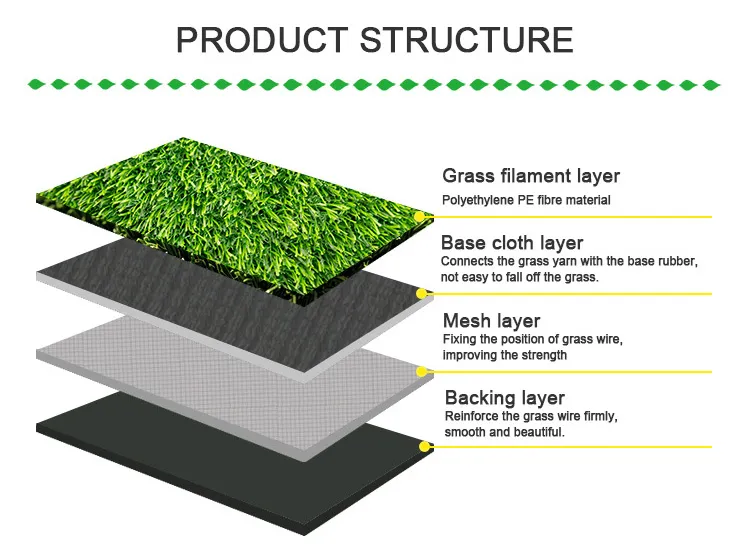
- Afrikaans
- Arabic
- Belarusian
- Bengali
- Czech
- Danish
- Dutch
- English
- Esperanto
- Estonian
- Finnish
- French
- German
- Greek
- Hindi
- Hungarian
- Icelandic
- Indonesian
- irish
- Italian
- Japanese
- kazakh
- Rwandese
- Korean
- Kyrgyz
- Lao
- Latin
- Latvian
- Malay
- Mongolian
- Myanmar
- Norwegian
- Persian
- Polish
- Portuguese
- Romanian
- Russian
- Serbian
- Spanish
- Swedish
- Tagalog
- Tajik
- Thai
- Turkish
- Turkmen
- Ukrainian
- Urdu
- Uighur
- Uzbek
- Vietnamese
laying artificial turf on soil
Dec . 23, 2024 08:27 Back to list
Laying Artificial Turf on Soil A Comprehensive Guide
Artificial turf has become an increasingly popular choice for homeowners and businesses looking to enhance their outdoor spaces with low-maintenance, aesthetically pleasing landscaping options. Unlike natural grass, synthetic grass offers a lush appearance year-round without the headaches of regular mowing, watering, or fertilizing. However, the installation process can be a bit complex, particularly when laying artificial turf on soil. This guide will walk you through the steps to achieve a successful installation.
Step 1 Planning and Measuring
Before you start laying artificial turf, it’s crucial to assess and plan the area where you intend to install it. Measure the space accurately to determine how much turf you will need. Consider the shape of the area and whether there are any obstacles, such as trees or garden beds, that may require special attention. Additionally, think about drainage and sunlight; proper drainage is essential for preventing water accumulation beneath the turf, which can lead to mold and deterioration.
Step 2 Preparing the Soil
The preparation of the soil is arguably one of the most critical steps in the installation process. Start by removing any existing grass, weeds, and debris from the area. You can utilize a shovel, hoe, or a sod cutter for larger areas to ensure a clean base. Once the area is clear, excavate to a depth of about 3 to 4 inches to make room for a proper sub-base.
Next, level the soil to create a smooth, even surface. This is vital because any bumps or dips in the ground can cause issues post-installation, affecting the appearance and functionality of the turf. After leveling, compact the soil using a plate compactor or by simply walking over it repeatedly to create a dense and stable base.
Step 3 Installing a Base Material
To promote proper drainage and provide a solid foundation for the artificial turf, you’ll need to lay a base material. Typically, crushed stone or gravel is used for this purpose. Spread about 2 to 3 inches of the material over the compacted soil, then rake it out evenly. Use a compactor again to ensure the base is firmly packed, creating an adequately stable surface for the turf.
After compacting, it’s a good idea to use a landscape fabric over the base material. This barrier will help prevent weed growth while allowing water to percolate through. Ensure the fabric extends beyond the area where the turf will be laid.
laying artificial turf on soil

Step 4 Laying the Artificial Turf
Now comes the exciting part laying down the artificial turf! Roll out the turf across the prepared area, making sure to align the seams carefully. If you have multiple pieces, ensure that the blades of grass are all facing the same direction to provide a uniform look. Use a utility knife to cut the turf as needed to fit around corners and obstacles.
Step 5 Securing the Turf
Once the turf is laid out to your satisfaction, it must be secured properly to prevent shifting over time. You can use landscape staples or nails to anchor the edges and seams into the base. Be sure to place these at intervals of about every 6 inches along the perimeter and every foot along seams.
Step 6 Adding Infill
Infill material, such as crumb rubber or silica sand, is often added to artificial turf to weigh it down, provide stability, and help the blades stand upright. Spread the infill evenly across the surface using a broom. This step not only increases the durability of the turf but also enhances its appearance.
Step 7 Final Touches
Finally, brush the turf with a stiff bristle brush to help the grass blades stand upright and remove any debris. Take a moment to inspect the area to ensure everything is secure and looks great.
Conclusion
Laying artificial turf on soil requires careful planning and execution, but the results can be profoundly rewarding. With a well-installed lawn, you can enjoy the beauty of a vibrant green space without the hassles of traditional lawn care. Follow these steps, and you’ll be well on your way to creating the perfect low-maintenance landscape for your home or business.
-
The Benefits of Artificial Turf for Indoors
NewsJul.15,2025
-
How Artificial Grass Suppliers Ensure Quality Products
NewsJul.15,2025
-
Artificial Grass and Pets: A Space for Relaxation
NewsJul.08,2025
-
Balcony & Outdoor Decoration with Artificial Grass
NewsJul.08,2025
-
Best Indoor Artificial Grass for Home
NewsJul.07,2025
-
Best Pet Turf for Dogs: Safe & Durable Artificial Grass Options
NewsJul.07,2025
Products categories









